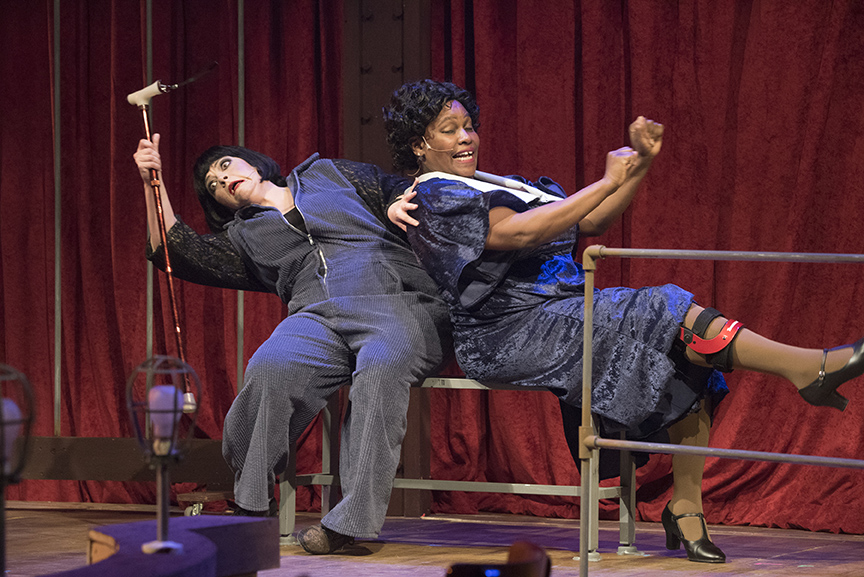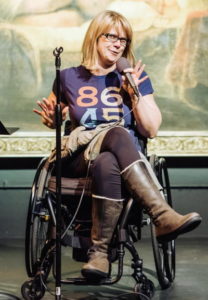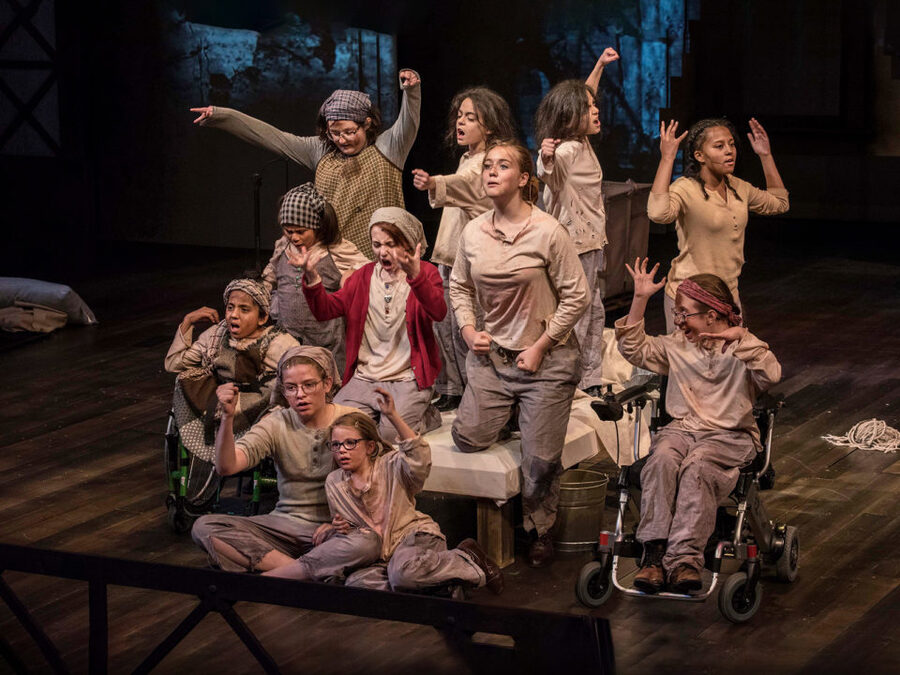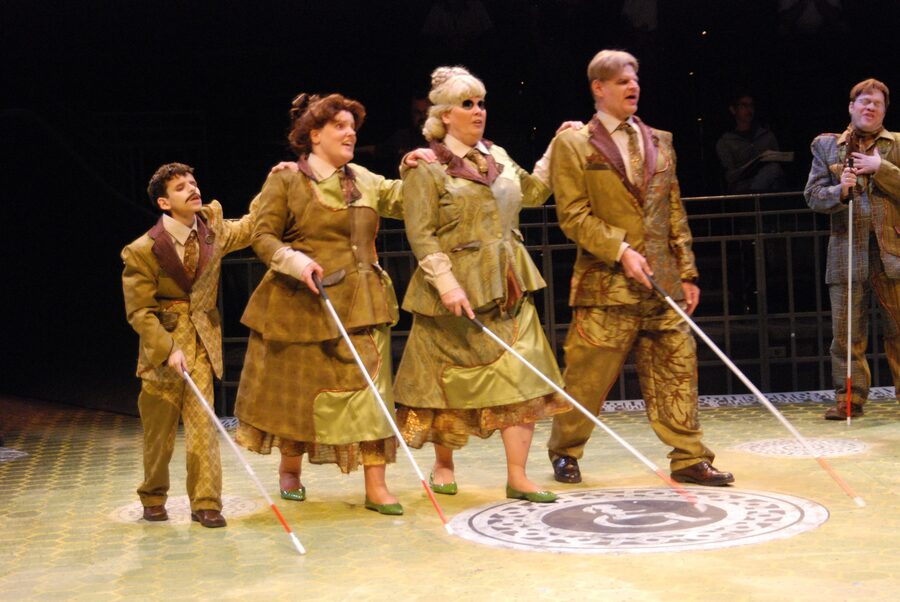From a tiny body sitting in an electric wheelchair comes a cackle. Actor Kalyn Heffernan’s laugh is the cue to start the “rabbit hole” scene. You know the one: the moment when Lewis Carroll’s Alice tumbles down, down, down into another world.
On a July evening in a rehearsal studio at the Denver Center for the Performing Arts, the Phamaly Theatre Company is deep into rehearsal for Alice in Wonderland, which will run Aug. 14-Sept. 5. Written by David Jacobi for the Denver company founded by and composed of people with disabilities, the show is the first commissioned mainstage work in Phamaly’s 31-year history.
Upon hearing that edgy chortle, two actors pantomime pushing Alice into a hole in the floor. Choreographed madness ensues. Heffernan—who also leads the band Wheelchair Sport Camp, which wrote the score for this production—is billed as Cheshire Cat Head. She and her two Cheshire pals whirl past Alice; three other performers enter twirling black-and-white umbrellas. As Alice walks back back back, our view of her is partially obstructed by the hypnotic spin of two of those parasols. From her own, less tricked-out wheelchair, director Regan Linton (she/her) offers suggestions.
Up next: something everyone keeps referring to as the “wobbly dance.” It’s an apt phrase. And no, not because the rehearsal has the usual rehearsal kinks, along with a few additional logistical and safety concerns. Instead, “wobbly dance” seems aptly descriptive of the variety of gaits and broad range of physical movements these actors experience and therefore imbue their characters with. To repurpose a quote from this magazine’s March series on disability and theatre: If an actor is born with osteogenesis imperfecta—as Heffernan was—then their character has that same condition.

In 1989, frustrated by the lack of opportunities to do theatre, five graduates of a Denver school for children with disabilities launched the Physically Handicapped Actors & Musical Artists League, a.k.a. PHAMALy. Those founders were in sync with the disability rights activism that led to the creation of the Americans with Disabilities Act. Phamaly’s first production took place in 1990, the year ADA was signed into law. Ever since, the company has been a practitioner of access activism, but not in some “let’s put on a nice social service organization” way some might imagine. From the start, it’s been about the art.

“I don’t know if it’s because of the geographic location of Phamaly, where we’re kind of in the middle of the country—maybe it’s partly the name,” said Linton, sitting with the company’s new artistic director, Ben Raanan (he/him), and managing director Sasha Hutchings (she/her) one afternoon. “When folks don’t understand the history of the name, there’s this assumption that we’re just doing social service theatre. And I think that’s an ableist assumption about disability in theatre in general across the country.”
When Alice opens mid-August at the Su Teatro Cultural and Performing Arts Center in Denver, it will join a long list of Phamaly mainstage musicals three decades long. (After its in-person run, Alice will stream Sept. 6–30.) Guys and Dolls (1990) was the first, and the last musical before the pandemic struck was Chicago in 2019. In addition to its annual musicals—which have been performed at the Denver Center and the Arvada Center, among other venues—the company stages plays and produces a company-written show called Vox Phamalia. CoronaVox: Stories From the Frontlines premiered virtually this past spring. Twelve years ago, Vox performed its first take on the Alice story.
“Our Alice was caught in the confusion and absurdity of the modern healthcare system, wading through the nonsense of insurance jargon and approvals and drug coverage and such,” Linton wrote in an email. When she became the company’s artistic director in 2016, she went looking for a music-driven version of the Alice story that could fit into the company’s summer musical slot. She was stymied. So she commissioned Jacobi, a University of California, San Diego MFA colleague.
“I had always known David’s work to be the perfect combination of absurdity, gravitas, and whimsy,” she recalled. “Unbelievably, he agreed to create a brand new version that would take our unique company into account throughout the scripting.”

From Phamaly’s first production, the very act of putting musicals onstage featuring actors with physical, cognitive, and/or developmental disabilities had a unique force. It insisted that audiences see classics such as Kiss Me Kate, A Funny Thing Happened on the Way to the Forum, and Joseph and the Amazing Technicolor Dreamcoat, to name just a few, differently. It pushed audiences to leave entertained but also with uncomfortable questions: about casting, about power, about vulnerability. For audience members with disabilities—or those wise enough to realize that will likely describe them someday, in some fashion—possibilities were teased, argued for, represented, and celebrated.
The company has only gotten bolder, making production selections that create a frisson between performer and text, audience and culture. When Phamaly reprised Side Show—the Tony-nominated musical about conjoined twins Daisy and Violet Hilton—in 2008, then Denver Post theatre critic John Moore wrote, “There may not be a more shocking opener than an entire snarling company of actors with wheelchairs, shuffling gaits, and malformed limbs getting all up in your grill, challenging you to ‘Come Look at the Freaks.’”
For years, Phamaly has dared audiences by daring itself. The company has continued to choose works that grapple with “othering”—making explicit the marginalizing of people with disability by refuting ableist assumptions about who can appear on stage and who they play once there. Milestones include The Elephant Man, Fiddler on the Roof, Cabaret, and Chicago. The staging of Annie in 2017 made clear that it can indeed be a hard knock life for children with disabilities—but doesn’t have to be if the culture at large holds mental, physical, and creative space for children with disabilities.
Linton calls it “the creativity model of disability. Living as a person with a disability is a creative experience; you are constantly having to create your own path because the path is not built for you. Your body literally is a creative, abstract thing. How can we see disability as a creative asset that also enhances artistic work?”
In addition to breaking new ground for the company, Alice in Wonderland will be something of a swan song for Linton, who took on an “interim” role when she joined as artistic director in 2016, intending to return to her acting career within a year. (She became Phamaly’s first artistic director with disabilities, and the nation’s first artistic director who does the job from a wheelchair.) In January, she announced on the company’s website that it was time “to continue onward and refocus my energies as a performer and theatre artist.” It will also be a proper introduction to the company’s new leader. After a nationwide search, Ben Raanan became artistic director in May.

During Alice rehearsals, Raanan took a supporting role. He would gently walk toward an actor to answer a question or quell an emotional breeze before it turned into a gale. Such was the evidence of his kinder, gentler side.

“I like to say I’m a militant disabled person,” he said the afternoon he, Linton, and Hutchings sat down for an interview. “For a very long time, the general public has tried to curate the emotions that disabled people can feel and disabled people can experience,” he continued, giving a hint at where Phamaly will continue to head under his lead.
“Disabled people do drugs; disabled people can be jerks,” he said. “We have this notion that all disabled people are beautiful souls and if they say something mean, it’s because society has made them do it. No, some people are just jerks. By not recognizing that, we’re actually dehumanizing, we’re homogenizing what disability is as a whole.”
So: All hail Roxie Hart for her killer instincts, or the Kit Kat Klub denizens for their sexual appetites, or John Merrick for his ache and anger. Raanan is ready to hold even more space for the darkness, the rage, and the friskiness. Earned whimsy will work too.
“Part of why I love Alice so much is that it kind of turns that trope on its head,” said Raanan. “It starts in this darker place, a mysterious place, and then introduces wackiness and zaniness and silliness.”
From the get-go, Phamaly has been driven by the ambitions of its artists. The will to make startling, moving, transformative work became a mission when Linton took the artistic director reins. Raanan now intends for it to become a sort of company mantra.
“We’re trying to make artistically rigorous work. That’s my word: rigorous,” he said. “Artistically rigorous theatre that conveys, ‘This is badass.’”
The Alice in Wonderland soundtrack landed on bandcamp.com a few days before the show’s premiere. Heffernan’s quasi trip-hop soundscape with songs and raps (created with her Wheelchair Sports Camp crew and ally Denver rocker Michelle Rocqet) is a wild and woolly, ecstatic and carnal, scathing and celebratory bit of business. It is carnivalesque. It is also weighty. One has come to expect no less from a company that has consistently pushed art first by holding and expanding creative space for artists.
Phamaly makes Alice’s tumble down the rabbit hole its own, and then, as it so often has, yanks a hare out of its metaphorical hat, plying its grounded magic to remake the journey for all. Now there’s your access. Voila!
Lisa Kennedy (she/her) is a critic and journalist who has covered film and theatre for decades, including at The Village Voice and The Denver Post.
Production credits: Chicago, with book by Fred Ebb and Bob Fosse; music by John Kander; direction by Regan Linton; music direction by Donna Debreceni; choreography by Debbie Stark, Gab Barnett, and Ronni Stark; dramaturgy by Jordan Kaplan; set design by Nick Renaud; costume design by Nicole Harrison; lighting design by Dave Mazzeno, sound design by Jason Ducat, props design by Rob Costigan, and puppet design by Katy Williams. Annie, with book by Thomas Meehan, music by Charles Strouse, lyrics by Martin Charnin, direction by Steve Wilson and Regan Linton, music direction by David Nehls and Trent Hines, choreography by Debbie Stark and Ronni Gallup, set design by Laura Love and Alex Polzin, costume design by Nikki Harrison, lighting design by Dave Mazzeno, sound design by Craig Breitenbach, video design by Topher Blair, and props design by Rob Costigan and Bob Bauer. Urinetown, with book and lyrics by Greg Kotis and Mark Hollmann, music by Hollmann, direction by Steve Wilson, music direction by Donna Debreceni, choreography by Debbie Stark and Cindy Bray, fight choreography by Geoffrey Kent, set design by Jennifer Orf and Charles Packard, lighting design by Stephen C. Mezzeno, sound design by Matthew Schwartz, and costume design by Mallory Kay Nelson.


